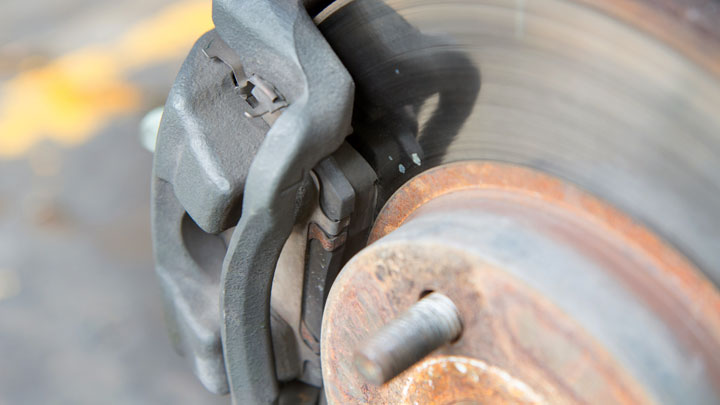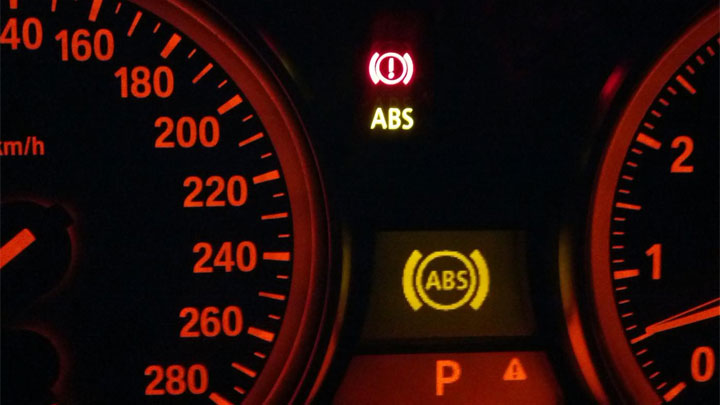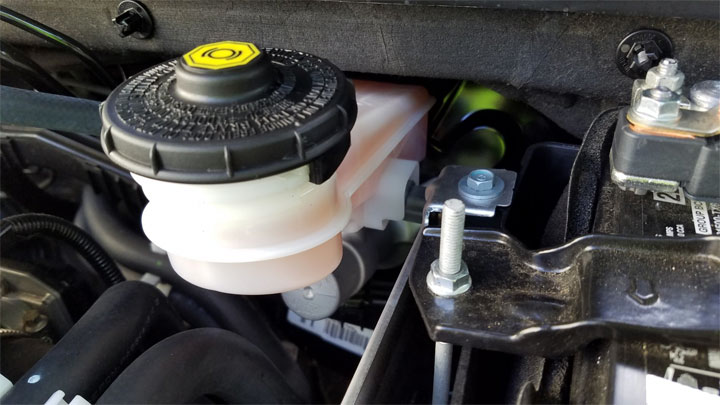Last Updated on June 13, 2022
When you step on the brakes, hydraulic fluid converts the brake pedal movement into a strong clamping force that stops your vehicle. Your brakes should be strong and reliable, since a short stopping distance could mean the difference between life and death if a small child or animal were to suddenly dart out in front of you.
Brake pads are the components that touch the brake rotors when the brake pedal is depressed, applying friction and pressure to the rotors to slow the turning of the wheels.
Vehicles with disc brakes have brake pads while vehicles with drum brakes do not. The latter is an older style of brake that is not as good at dissipating heat or at slowing the vehicle in wet weather.
Since brake pad material gets slightly used up each time you step on the brake pedal, they won’t last forever. So how long do brake pads last and what affects their average lifespan?
How Brake Pads Wear

Since brake pads help slow the vehicle down by contacting the moving rotors on the wheels, they experience a lot of friction which wears away the brake pad material. The friction also heats up the brakes, which breaks down the pads over time.
Average Life of Brake Pads
Brake pads are a consumable part since the pad wears down with use. Though there are many factors that can determine the time that brake pads can be safely used on your vehicle, the average lifespan is somewhere between 30,000 and 70,000 miles for most vehicles.
Repeated hard stops will drastically reduce the life of the brake pads but this is expected behavior in a performance application, such as a sports car at a track day.
See Also: Reasons Why Brake Pads Wear Unevenly
Factors That Influence Brake Pad Life
The average brake pad life depends on several factors, including pad material, driving conditions, vehicle type and load, and personal driving style. Here are a few things that affect how long brake pads last.
- Driving in areas that require a lot of braking such as mountainous roads or in a place with many stops such as in town or in stop-and-go traffic will wear down the brakes faster, simply because they experience more friction and heat.
- Larger, heavier vehicles usually come with stronger, tougher brake pads since they need more help slowing and stopping something with such a large momentum. Vehicles such as semi-trucks that are expected to carry a large load usually have the same or better brake pad lifespan as road cars, but a passenger vehicle that is frequently used to haul heavy loads will wear out the brake pads much sooner.
- Drivers who use both feet to operate the brake and gas pedals have a tendency to “ride” the brakes with their left foot. This causes the brake pad material to wear at a much faster rate.
- Performance vehicles need better brake pads because they often drive near the limits of the vehicle, rapidly accelerating and decelerating. Drivers who take regular street pads to a track day or autocross event could even chew through the pads after an event or two, since street pads are generally not intended to be used for repeated hard stops in this way.
- Drivers who follow other vehicles too closely experience faster brake pad wear than more patient drivers. The close following distance means they have less time to react, which leads to repeated and more abrupt braking.
- Smooth, steady braking makes the pads last longer. It will save your other brake system components from unnecessary wear as well.
- Ceramic pads generally have the longest lifespan. Semi-metallic pads are the next best, and organic pads usually have the shortest life.
- If the ABS (anti lock braking system) kicks on, it shortens the braking distance as intended but may increase pad wear on the rear pads dramatically.
- When you brake, the vehicle’s weight shifts toward the front axle. This puts more of the braking responsibility on the front brakes, which is why they are usually larger and wear faster. A proportioning valve is a device used to balance the front to rear brake bias.
- The proportioning valve is a mechanical device on older vehicles. Newer vehicles with ABS use an electronic proportioning valve that sends more braking ability to the rear with ABS ready to step in if the rear brakes lock up.
When to Replace Brake Pads
It’s a good idea to check the brake pads with every oil change since the lifespan can vary so greatly. Also check the service manual for your vehicle for the recommended replacement intervals.
It’s always best to replace the brake pads before noticing any symptoms to prolong the life of the other components such as rotors and calipers.
Brake pads actually aid in heat dissipation. When the pads wear, they are not able to take on as much heat and become more prone to brake fade.
As a rule of thumb, you want to consider replacing the pads when the brake pad thickness is the same thickness as the backing plate. Try not to wait until you hear that awful squealing noise from the pad wear indicator!
Rotors normally wear with time due to the friction of the brake pads. They just last longer than the pads because they can be resurfaced (made flat and even again) a few times before needing replacement.
If you see any of the following symptoms of brake pads starting to fail, make sure they are replaced immediately, ideally with the same type of material.
See Also: Replacing vs Resurfacing Brake Rotors (How to Choose)
#1 – Squealing or Squeaking

Brakes often squeal during wet weather but if you hear this sound during all types of weather, get it checked out. Some brake pads have a metal toothed area on the innermost section which makes strange noises as it spins to alert the driver that it’s time to replace the pads.
Related: New Brakes Squeaking or Squealing? (5 Reasons Why)
#2 – Thin Brake Pads

The pads can be inspected externally between the spokes of the wheel. If they appear to be less than a quarter of an inch thick, have them checked. Many auto manufacturers recommend them to be replaced at 0.1” but it’s better to be cautious than wait too long.
#3 – Indicator Light

Some modern vehicles have an indicator light when there is something wrong with the braking system and may tell you when the brake pads need replacement.
#4 – Vibrating or Squishy Brake Pedal

If the brake pedal vibrates or feels otherwise strange when it is depressed the pads may need to be changed. The pedal may need to be pushed quite far to brake adequately.
A “squishy” pedal can also be caused by different braking system troubles such as bubbles in the brake fluid, so have the vehicle checked immediately to avoid a dangerous accident.
If your brake pedal feels spongy or goes to the floor too easily, check to make sure you have enough brake fluid. Do not drive the vehicle without brake fluid in the brake master cylinder reservoir.
#5 – Metallic Grinding or Crunching While Braking

Once the brake pads are nearly or completely worn away, you’ll hear these telltale sounds of metal-on-metal contact between the rotor and caliper, which will quickly wear both of those components and may not work sufficiently to stop your vehicle in time.




